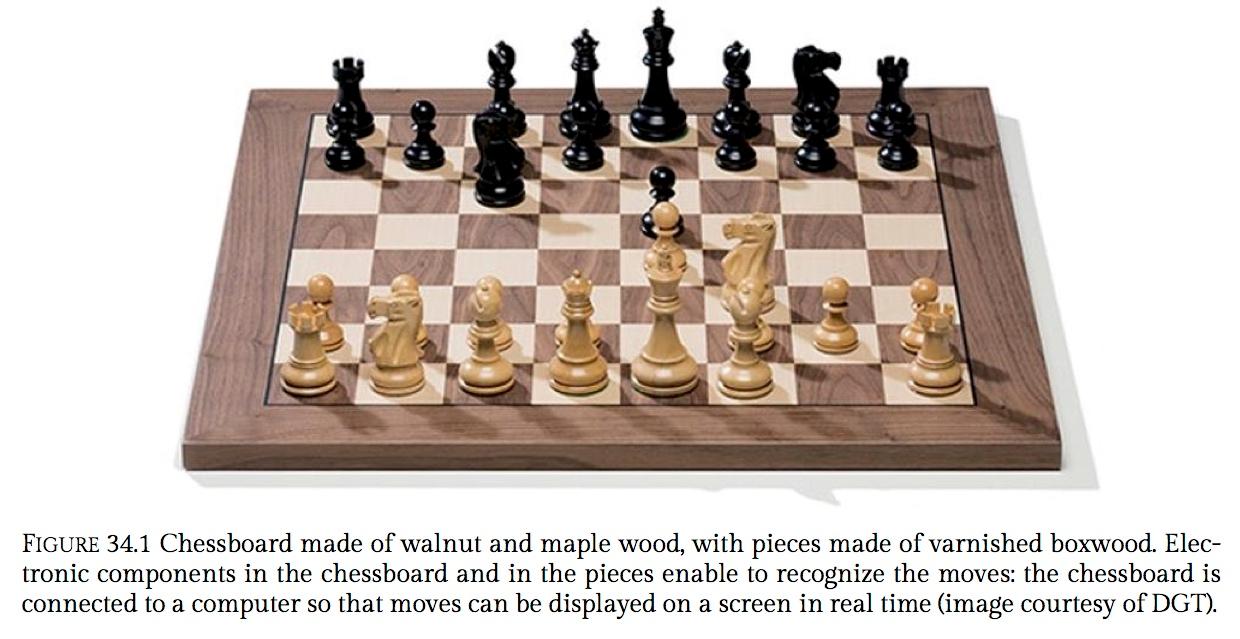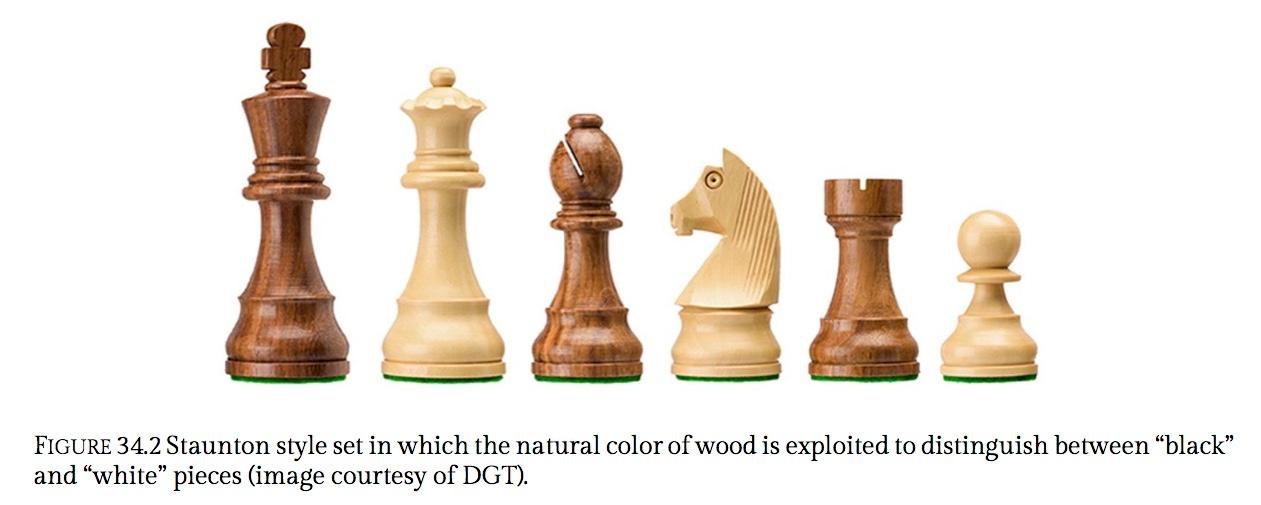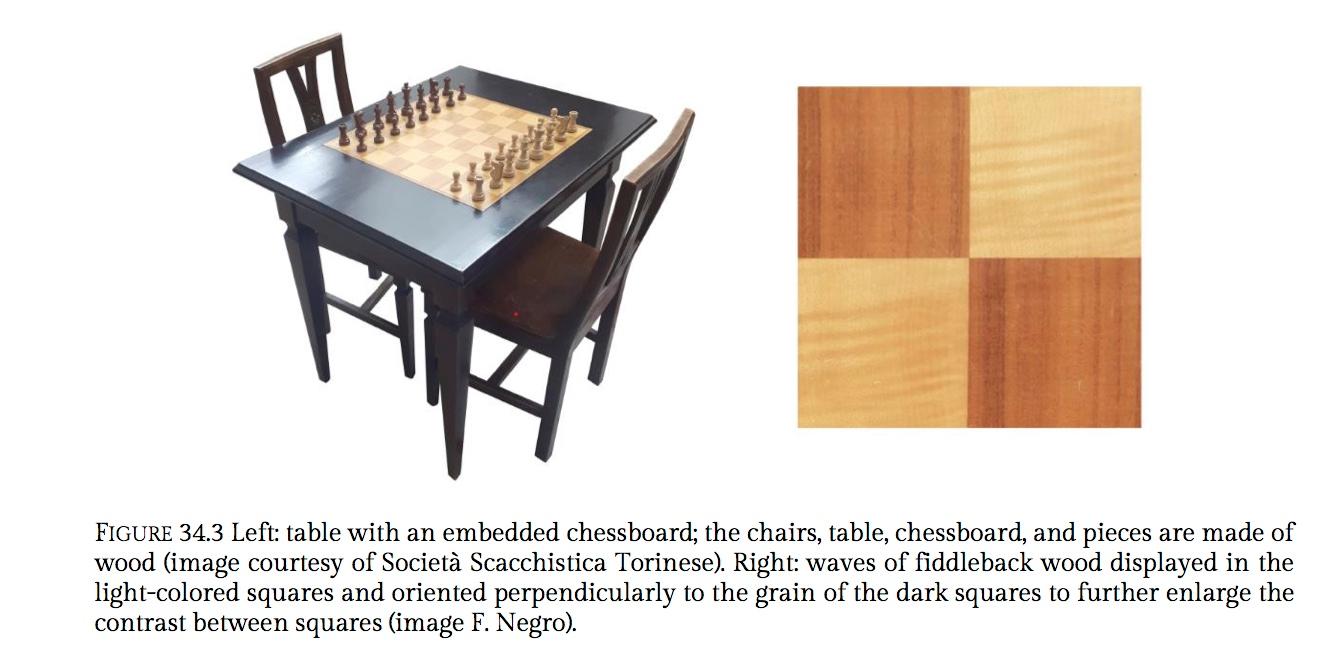In the service of Queens and Kings
This chapter is extracted form the book Wood in Sport Equipment - Heritage, present, perspective
(doi: 10.22382/book-2022-01)
by Francesco Negro
The book was funded by the World Wood Day Foundation and is available for free download at: https://www.swst.org/wp/publications/other-publications/books/
ORIGIN AND PRESENT OF CHESS
Chess is among the oldest and more widespread mind sports in the world. The origin of chess dates to the 6th century AD when, in India, its predecessor was named chaturanga. This can be translated into “four divisions of the military”, from which the chess pieces pawn, knight, bishop, and rook derive (FIDE 2009). Over time the name evolved, until the Persian denomination shah (king) became the modern term chess. The rules of chess also evolved over time, and by the 15th century AD chess had acquired the form that has substantially arrived in the present day. During the last decades computer science has greatly impacted on the world of chess. Playing software has grown ever stronger, online games have become widespread at a global level, and games played in person on electronic chessboards can be followed in real time worldwide (FIGURE 34.1).
The International Chess Federation (FIDE), the governing body of chess, was founded in 1924 and recognized by the International Olympic Committee as a Global Sporting Organization in 1999. Nowadays chess continues to be played worldwide: 195 countries are affiliated to the FIDE, and more than 60 million games are estimated to be played every day [1].

In addition to the recreational and competitive aspects, chess has a relevant educational value. Chess is taught in school programs all around the world, courses are offered to professionals to empower their reasoning skills, and so on. Overall, being skilled in chess is perceived as a value.
Chess pieces and chessboards can be made of varied materials: plastic, bone, clay, marble, glass, wood, etc. Among these, wood can arguably be defined as the most important, considering its tradition, diffusion, and aesthetic value. Many examples could be chosen to confirm this, one being the expression “woodpusher”. This is used among chess players to ironically depict someone who, without any strategy, plays by just pushing the pieces. The fact that the term wood is used in such an expression is emblematic of the strict connection between wood and chess. In this sense, one can also note that in chess software, the moves and captures of pieces are often accompanied by the wooden sounds that are so familiar to chess players.
WOOD IN THE FIDE RULES
Wood and wood species are repeatedly mentioned by the FIDE handbook (FIDE 2018), which prescribes that “Chess pieces should be made of wood, plastic or an imitation of these materials”. According to the handbook, the natural color of wood can be exploited to make white and black pieces: “The ‘black’ pieces should be brown or black, or of other dark shades of these colors. The ‘white’ pieces may be white or cream, or of other light colors. The natural color of wood (walnut, maple, etc.) may also be used for this purpose” (FIGURE 34.2).
Similarly, the natural color of wood can be exploited in chessboards: “Natural wood with a sufficient contrast, such as birch, maple or European ash against walnut, teak, [...] may also be used for boards, which must have an opaque or neutral finish, never shiny”. It is worth of note that wood is indicated as the material of choice for the most relevant competitions: “For the World or Continental top level competitions wooden boards should be used. For other FIDE registered tournaments, boards made of wood, plastic or card are recommended”.

WOOD IN CHESS PIECES
Wooden chess pieces are typically handmade on a lathe. Additional details, such as the knight’s mane, are sculpted afterwards. Metal weights can be included into the bases of pieces to lower their center of gravity and improve their stability, and the bases can be overlaid with wool felt.
A wide variety of wood species is used to make chess pieces. Typically, noble hardwoods are used, such as maple, walnut, boxwood, rosewood, sheesham, ebony, etc.
The use of noble hardwoods can be attributed to various reasons. A relevant element lays in the high symbolic value of the “game of kings”, which possesses a traditional and intellectual image that encourages the realization of valu- able chess sets. It is not by chance that chess sets are often displayed in homes as valuable, elegant furniture pieces. The same is valid for tables with chessboards embedded into the top (FIGURE 34.3 left), whose crafting can also reach cabinetry levels.
The choice of the wood species is also re- lated to technical reasons. As above men- tioned, color contrast is required by both pieces and squares. Choosing wood with fine texture also enables the precise sculpting of the details, as in the case of the knight’s eyes. Finally, denser wood also enables stabler pieces.
As for the style of the pieces, Staunton (FIGURE 34.2) is the most widespread, and noteworthy is that the FIDE handbook recommends the use of such style in competitions.

The FIDE also recommends the height of the pieces (from 9.5 cm for the king, to 5 cm for the pawn), and that the diameter of the base is 40-50% of the height of the pieces. However, several styles of pieces are on the market, the limit being the imagination. An example are the chess sets inspired by the 1972 World Chess Championship, played by Fischer vs. Spassky, and known as the “Match of the Century”. Another example is that of chess sets inspired by the Queen’s gambit series. Handcrafted and artistic wooden chess sets with unique design, and often of high value, shall also be mentioned here.
WOOD IN CHESSBOARDS
Wooden chessboards can be made of solid wood or of a supporting wood-based panel overlaid with sliced veneers. The broad range of the above-mentioned noble hardwoods is also used in chessboards (several models of wooden chess clocks also exist). Of note, the wood species of a chessboard are not necessarily the same as the pieces placed on it. The size of the squares shall be proportioned to the base of the pieces; the FIDE handbook recommends 5-6 cm long square sides.
Electronic boards are made of an inner supporting wood-based panel (MDF or plywood) that is milled to reduce the overall weight and to fit the electronic components. An antenna foil is sandwiched between the core and a thin carrier panel, on top of which the checkered, high-quality veneers are applied. These boards detect and recognize the chess pieces and their movements, thanks to the communication between the antenna foil inside the board and resonators embedded in the electronic chess pieces. The moves can be displayed on screen in real time through USB or Bluetooth connection.
Finally, an interesting detail can be found in chessboard squares that purposely show fiddleback grain (FIGURE 34.3 right). This is an aesthetic effect that results from the wavy grain of timber: after sawing or slicing, shiny waves can be seen on the surface of wood due to the different incident angle by which the light hits the wood grain.
Francesco Negro
(DISAFA, University of Torino, Grugliasco, Italy)
ACKNOWLEDGEMENTS
DGT is thanked for the valuable information provided. Renato Mazzetta and Mauro Barletta (Società Scacchistica Torinese) are thanked for their valuable feedback. Tiziana Barbiso is thanked for having checked (which seems an appropriate term) the text.
REFERENCES
FIDE (2018). Handbook C. General Rules and Technical Recommendations for Tournaments 02. Standards of Chess Equipment, venue for FIDE Tournaments, rate of play and tie-break regulations. Available at https://handbook.fide.com/chapter/C02 [accessed on 03 February 2022].
FIDE (2009). Game of chess and its history. Available at https://old.fide.com/fide/fide-world-chess-federation.html [accessed on 03 February 2022].
[1] www.fide.com [accessed on 03 February 2022].
Websites:
https://digitalgametechnology.com/
(doi: 10.22382/book-2022-01)
by Francesco Negro
The book was funded by the World Wood Day Foundation and is available for free download at: https://www.swst.org/wp/publications/other-publications/books/
ORIGIN AND PRESENT OF CHESS
Chess is among the oldest and more widespread mind sports in the world. The origin of chess dates to the 6th century AD when, in India, its predecessor was named chaturanga. This can be translated into “four divisions of the military”, from which the chess pieces pawn, knight, bishop, and rook derive (FIDE 2009). Over time the name evolved, until the Persian denomination shah (king) became the modern term chess. The rules of chess also evolved over time, and by the 15th century AD chess had acquired the form that has substantially arrived in the present day. During the last decades computer science has greatly impacted on the world of chess. Playing software has grown ever stronger, online games have become widespread at a global level, and games played in person on electronic chessboards can be followed in real time worldwide (FIGURE 34.1).
The International Chess Federation (FIDE), the governing body of chess, was founded in 1924 and recognized by the International Olympic Committee as a Global Sporting Organization in 1999. Nowadays chess continues to be played worldwide: 195 countries are affiliated to the FIDE, and more than 60 million games are estimated to be played every day [1].

In addition to the recreational and competitive aspects, chess has a relevant educational value. Chess is taught in school programs all around the world, courses are offered to professionals to empower their reasoning skills, and so on. Overall, being skilled in chess is perceived as a value.
Chess pieces and chessboards can be made of varied materials: plastic, bone, clay, marble, glass, wood, etc. Among these, wood can arguably be defined as the most important, considering its tradition, diffusion, and aesthetic value. Many examples could be chosen to confirm this, one being the expression “woodpusher”. This is used among chess players to ironically depict someone who, without any strategy, plays by just pushing the pieces. The fact that the term wood is used in such an expression is emblematic of the strict connection between wood and chess. In this sense, one can also note that in chess software, the moves and captures of pieces are often accompanied by the wooden sounds that are so familiar to chess players.
WOOD IN THE FIDE RULES
Wood and wood species are repeatedly mentioned by the FIDE handbook (FIDE 2018), which prescribes that “Chess pieces should be made of wood, plastic or an imitation of these materials”. According to the handbook, the natural color of wood can be exploited to make white and black pieces: “The ‘black’ pieces should be brown or black, or of other dark shades of these colors. The ‘white’ pieces may be white or cream, or of other light colors. The natural color of wood (walnut, maple, etc.) may also be used for this purpose” (FIGURE 34.2).
Similarly, the natural color of wood can be exploited in chessboards: “Natural wood with a sufficient contrast, such as birch, maple or European ash against walnut, teak, [...] may also be used for boards, which must have an opaque or neutral finish, never shiny”. It is worth of note that wood is indicated as the material of choice for the most relevant competitions: “For the World or Continental top level competitions wooden boards should be used. For other FIDE registered tournaments, boards made of wood, plastic or card are recommended”.

WOOD IN CHESS PIECES
Wooden chess pieces are typically handmade on a lathe. Additional details, such as the knight’s mane, are sculpted afterwards. Metal weights can be included into the bases of pieces to lower their center of gravity and improve their stability, and the bases can be overlaid with wool felt.
A wide variety of wood species is used to make chess pieces. Typically, noble hardwoods are used, such as maple, walnut, boxwood, rosewood, sheesham, ebony, etc.
The use of noble hardwoods can be attributed to various reasons. A relevant element lays in the high symbolic value of the “game of kings”, which possesses a traditional and intellectual image that encourages the realization of valu- able chess sets. It is not by chance that chess sets are often displayed in homes as valuable, elegant furniture pieces. The same is valid for tables with chessboards embedded into the top (FIGURE 34.3 left), whose crafting can also reach cabinetry levels.
The choice of the wood species is also re- lated to technical reasons. As above men- tioned, color contrast is required by both pieces and squares. Choosing wood with fine texture also enables the precise sculpting of the details, as in the case of the knight’s eyes. Finally, denser wood also enables stabler pieces.
As for the style of the pieces, Staunton (FIGURE 34.2) is the most widespread, and noteworthy is that the FIDE handbook recommends the use of such style in competitions.

The FIDE also recommends the height of the pieces (from 9.5 cm for the king, to 5 cm for the pawn), and that the diameter of the base is 40-50% of the height of the pieces. However, several styles of pieces are on the market, the limit being the imagination. An example are the chess sets inspired by the 1972 World Chess Championship, played by Fischer vs. Spassky, and known as the “Match of the Century”. Another example is that of chess sets inspired by the Queen’s gambit series. Handcrafted and artistic wooden chess sets with unique design, and often of high value, shall also be mentioned here.
WOOD IN CHESSBOARDS
Wooden chessboards can be made of solid wood or of a supporting wood-based panel overlaid with sliced veneers. The broad range of the above-mentioned noble hardwoods is also used in chessboards (several models of wooden chess clocks also exist). Of note, the wood species of a chessboard are not necessarily the same as the pieces placed on it. The size of the squares shall be proportioned to the base of the pieces; the FIDE handbook recommends 5-6 cm long square sides.
Electronic boards are made of an inner supporting wood-based panel (MDF or plywood) that is milled to reduce the overall weight and to fit the electronic components. An antenna foil is sandwiched between the core and a thin carrier panel, on top of which the checkered, high-quality veneers are applied. These boards detect and recognize the chess pieces and their movements, thanks to the communication between the antenna foil inside the board and resonators embedded in the electronic chess pieces. The moves can be displayed on screen in real time through USB or Bluetooth connection.
Finally, an interesting detail can be found in chessboard squares that purposely show fiddleback grain (FIGURE 34.3 right). This is an aesthetic effect that results from the wavy grain of timber: after sawing or slicing, shiny waves can be seen on the surface of wood due to the different incident angle by which the light hits the wood grain.
Francesco Negro
(DISAFA, University of Torino, Grugliasco, Italy)
ACKNOWLEDGEMENTS
DGT is thanked for the valuable information provided. Renato Mazzetta and Mauro Barletta (Società Scacchistica Torinese) are thanked for their valuable feedback. Tiziana Barbiso is thanked for having checked (which seems an appropriate term) the text.
REFERENCES
FIDE (2018). Handbook C. General Rules and Technical Recommendations for Tournaments 02. Standards of Chess Equipment, venue for FIDE Tournaments, rate of play and tie-break regulations. Available at https://handbook.fide.com/chapter/C02 [accessed on 03 February 2022].
FIDE (2009). Game of chess and its history. Available at https://old.fide.com/fide/fide-world-chess-federation.html [accessed on 03 February 2022].
[1] www.fide.com [accessed on 03 February 2022].
Websites:
https://digitalgametechnology.com/
